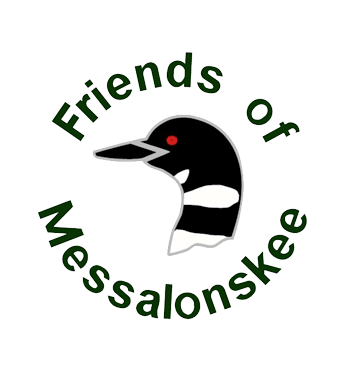Messalonskee Lake is home to many species of birds.



The Messalonskee Lake watershed contains a wealth of water resources including 3,730 acres of lakes and ponds, 79 miles of perennial and intermittent streams, 3,796 acres of freshwater wetlands, and 4,497 acres of riparian habitat. The largest wetland in the watershed,Messalonskee Lake Marsh, surrounds the outlet of Belgrade stream at the south end of the lake and includes nearly 1,300 acres of significant inland waterfowl and wading bird habitat (IWWH).
The lake and its associated wetlands provide scenic benefits for recreational users, and habitat for a number of endangered, threatened, or bird species of special concern. The marsh is the largest nesting site in Maine for the black tern (Chlidonias niger) and hosts other rare and uncommon species including the least bittern (Ixobrychus exilis), American coot (Fulica americana), and the scarlet bluet (Enallagma pictum). In 2021, 40 adult loons (Gavia immer) and 4 chicks were documented on the lake setting the record for the greatest number of adult loons counted in any year since 1983.
Loon count date for Messalonskee Lake


Friends of Messalonskee (FOM) Watershed Wildlife Awareness
From: Connor White
When you think of wildlife in the Messalonskee Watershed, what species come to mind? Most people quickly think of loons, bald eagles, waterfowl, painted turtles, and fish. Did you know that animals, such as moose, deer, fox, bobcat, owl, hawk, and songbirds are also affected by our watershed’s water quality?
● The Messalonskee Watershed encompasses 7 towns, comprising 44 square miles. Water from hundreds of creeks and streams flow from higher ground to rivers that eventually make it into Messalonskee Lake.
● The water flows down from higher ground, it often picks up nutrient runoff that drains into our lake (through the process of eutrophication). In excess, nutrient runoff has lasting effects on the ecology of a watershed. It leads to lower levels of oxygen dissolved in the water, and the same nutrient run off excessively feeds algae, eventually causing algal growth that blocks light needed for aquatic plants to develop. When the shaded-out and oxygen deprived plants die, the decaying process also absorbs oxygen in the water, further decreasing dissolved oxygen rates in our lake. As aquatic vegetation and oxygen levels begin to decline, wildlife such as bait fish, crayfish, mussels, and other aquatic life start to die off. These species are favored food sources by terrestrial and aquatic wildlife found in our watershed. As food sources change, wildlife dependent on those food sources are impacted by the change. The trophic impacts from a shift in biomass of primary producers and consumers carries up the food chain, and can cause an ecological imbalance.
● We are approaching uncharted waters, and the overall impacts from a loss of water quality in Messalonskee’s watershed are uncertain. One thing is for sure, the wildlife we enjoy sharing this landscape with are at risk. If we don’t act as a community then the natural world within our watershed will change, and not for the better. Friends of Messalonskee (FOM) Watershed has been collecting media of terrestrial and aquatic wildlife within the watershed to raise awareness to the public that our watershed, and the impacts of water quality, extend beyond the shoreline of our lake and streams.
● Join us on the FOM Facebook page as we begin sharing photos and videos of wildlife documented within the watershed in an awareness effort we are calling “FOM Watershed Wildlife”.

